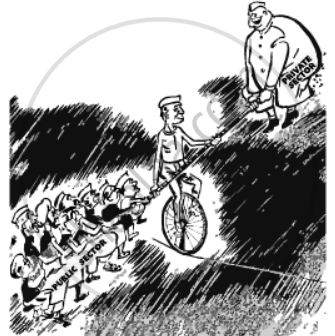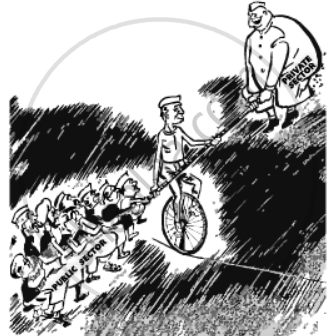Advertisements
Advertisements
प्रश्न
Which of these statements about the Bombay Plan is incorrect?
पर्याय
It was a blueprint for India's economic future.
It supported state-ownership of industry.
It was made by some leading industrialists.
It supported strongly the idea of planning.
उत्तर
It supported state-ownership of industry.
Explanation:
The Bombay Plan is the term given to a group of ideas made during World War II for the development of India's post-independence economy. The Bombay Plan" was the name given to a 15-year economic plan for India proposed in January 1944 by a group of entrepreneurs and technocrats. Initially, it was exclusively available for private distribution. In response to the interest produced by the idea, it was soon published as a pamphlet.
संबंधित प्रश्न
What were the major differences in the approach towards development at the time of Independence? Has the debate been resolved?
The Socialist model of development was related to ______.
Tribals of Odisha fear their displacement due to the extraction of which mineral?
In India, planning was conceived as the main instrument of ______.
NITI AYOG was established on ______.
Tripura State Planning Board was set up in ______.
Who amongst the following is the longest serving member of Tripura State Planning Board?
______ Policy has been adopted by NITI Aayog.
During the Nehru era, why did some political parties and groups in our country believe that India should be more friendly with the bloc led by the US?
Observe the figure below and answer accordingly.

Who in the picture is balancing between the public and private sectors?
Observe the figure below and answer accordingly.

Which type of economic model was adopted by India?
Read the following paragraph and answer according.
NITI Aayog or National Institution for Transforming India Aayog is basically a policy think tank of Government of India and State Governments that replaces the 65-year old Planning Commission.
The Union Government of India had announced formation of NITI Aayog on 1st January, 2015. The body is composed of a CEO and a Vice Chairperson, to be appointed by the Prime Minister, in addition to some full-time members and two part-time members, while four Union Ministers would serve as ex-officio members.
Besides, there would be specific regional councils, while experts and specialists from various fields would be called as special invitees nominated by the Prime Ministers.
NITI Aayog will serve as a “think tank” of the government as a “directional and policy dynamo” and would provide both to the governments at the centre and in the states with strategic and technical advice on key policy matters including economic issues of national and international importance.
NITI Aayog will have regional councils to focus on developmental activities on specific areas and is patterned on the National Reforms Development Commission of China.
How will NITI Aayog serve India?
The Planning Commission was established in the year
Following are a few points given on the approach towards development at the time of Independence. Which of them is correct?
- The common perception of Development was becoming modernized which involved the breakdown of traditional social structure
- After independence India had two models of development one was Europe's and US's liberal capital model and the other USSR's socialist model.
- Many including the Communist Party of India and leaders like Nehru. were impressed by the Soviet model and very few favored the American models.
Read the following passage and answer the question.
"In the early years of Independence, two contradictory tendencies were already well advanced inside the Congress Party. On the one hand, the national party executive endorsed socialist principles of state ownership, regulation, and control over key sectors of the economy in order to improve productivity and at the same time curb economic concentration. On the other hand, the national Congress ·government pursued liberal economic policies and incentives to private investment that was justified in terms of the sold criterion of achieving a maximum increase in production". - Francine Frankel
What is the contradiction that the author is talking about? What would be the political implications of a contradiction like this?
Which of the following option is true in the context of the "Kerala Model"?
Which two model of development India had adopted on the eve of independence?
Which of the following is/are correct about the Bombay plan?
In which year was the NITI Aayog constituted?
When was NITI Aayog constituted?
Who was the first vice chairperson of NITI Aayog?
Which of the following facts is/are incorrect about National Development Council?
Which of the following statements about NITI Aayog are true?
- NITI Aayog acts as a think tank of the Union Government.
- NITI Aayog acts against terrorism.
- NITI Aayog acts in a spirit of cooperative federalism.
- NITI Aayog design strategic and long term policy and programme frameworks.
Which factor was responsible for discouraging research and development in the manufacturing sector?
Which of the following statements about NITI Aayog are true?
- NITI Aayog acts as a “think tank” of the Union Government.
- NITI Aayog acts against terrorism.
- NITI Aayog acts in the spirit of cooperative federalism.
- NITI Aayog decides more roles for bigger states and smaller roles for smaller states.
Choose the correct option:
Planning Commission was set up by ______.
